
This section covers the Greco-Roman stories of the Underworld, the realm of the spirits of the dead, and the story of the greatest musician, Orpheus, who had a tragic experience there.
The second half of this section begins the survey of the greatest mortal heroes of mythology, starting with the family line of Perseus of Argos.
Contents
One of the eternal mysteries of humanity is the question of what happens after we die. Here we will see some of the evidence pertaining to the ideas of the afterlife in Greco-Roman culture.
In the Adonis section we saw some images of Hades, Zeus' brother who ruled the Underworld, when he abducted Persephone. Here are further images of Hades (known as Pluto to the Romans).
First, a Roman sculpture.

Hades
Next, a painting by Carracci.
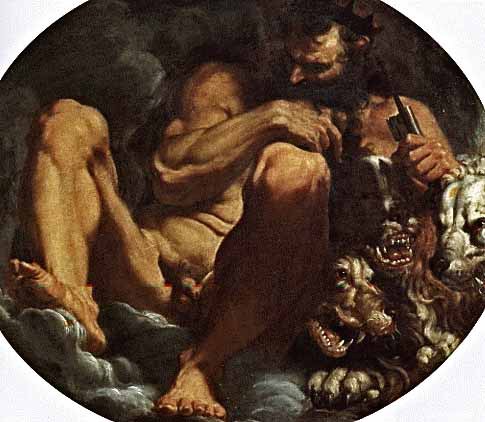
Carracci
Here is a ceiling mural by Caravaggio, with the three brothers Zeus, Poseidon, and Hades, observing the world.
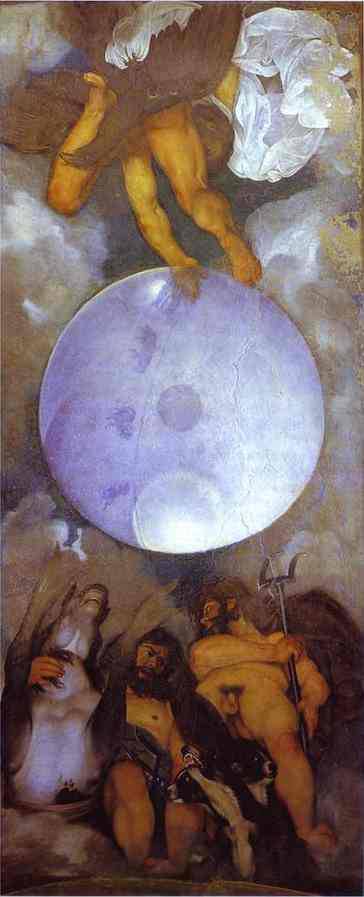
Caravaggio
All of these works include the monstrous three-headed dog Cerberus, who is seen alone, below, in a drawing by author/artist William Blake (1757-1827), from an illustrated version of Dante's Inferno.
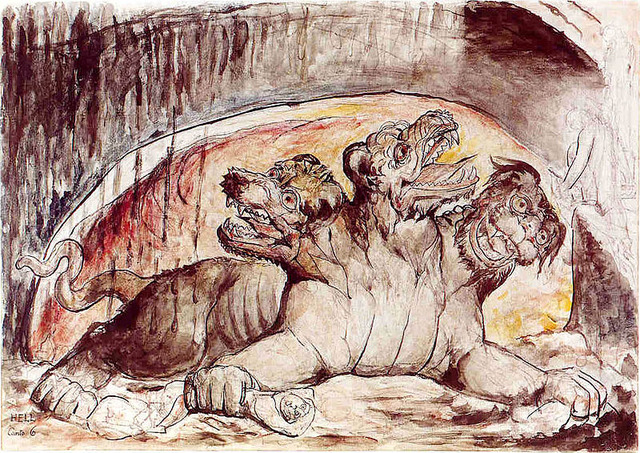
Blake
Many of the myths of the Underworld focus on certain individuals who suffer eternal punishments for their misdeeds. There is a recurrent theme among them of an endless, repetitive task, performed for eternity. The first example here is a black figure vase painting of Sisyphus, forever rolling a boulder uphill.

Sisyphus
Next is a red figure vase painting of Ixion lashed to a flaming wheel, surrounded by the Furies.

Ixion
The third image from a Roman sarcophagus combines Sisyphus and Ixion with a third character, Tantalus, forever trying to lift a handful of water to his mouth, but it slips through his fingers.

Sarcophagus
The last two paintings, both from the late 1800s, show a group of Io's descendants, the daughters of Danaus, or Danaïds. Aegyptus, the brother of Danaus, wanted his sons to marry their cousins, the Danaïds, but Danaus was set against it. He could not prevent the marriages, but he convinced his daughters to each take a dagger into the bedroom on the wedding night and kill their husband. All but one of the Danaïds did so, thus earning them an eternal punishment in the Underworld, seen here in the first painting by John William Waterhouse (1849-1917). They must spend eternity trying to fill an urn with a hole in the bottom with water.

The Danaides - Waterhouse (1902)
Then, by John Singer Sargent (1856-1925), one of several mythological murals done for the Museum of Fine Arts, Boston.
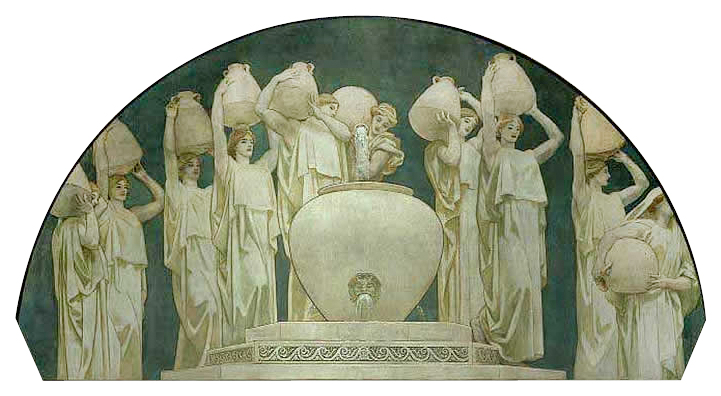
The Danaides - Sargent (1922-25)
This sarcophagus depicts Charon the boatman, whose job it is to transport the dead across the river to the Underworld. Here, he is holding out his hand for his fare, the reason why many people in ancient times were buried with a coin in their mouth.

Charon
The next painting is another view of Charon's ferry by the Renaissance artist Joachim Patinir (1483-1524). The myth apparently has been somewhat 'Christianized' with angels on one side and the gloomy Underworld on the other.

Crossing the River Styx - Patinir (1520-24)
One of the most important works of Roman literature is Virgil's Aeneid, the story which traces the mythical quest of Aeneas, a survivor of the Trojan war who was destined to start a kingdom in Italy, which would one day become the Roman empire. One of the most interesting chapters of the Aeneid concerns his journey through the Underworld, seeking the spirit of his father Anchises, a character introduced in section four, as one of Aphrodite's few mortal lovers.
The painting below by Giuseppe Maria Crespi (1665-1747) shows Aeneas, escorted by the priestess known as the Sibyl of Cumae, as they board Charon's ferry.

Aeneas, Sibyl and Charon - Crespi (1695)
Next are two versions of the same scene, both by Flemish artist Jan Brueghel (1568-1625), the son of the famous Pieter Bruegel, depicting Aeneas and the Sibyl as they travel through the Underworld.

Aeneas and Sibyl in the Underworld - Jan Brueghel (1600)

Aeneas and Sibyl in the Underworld - Jan Brueghel (1619)
Perhaps the one thing that Michelangelo is most known for today is his work on the ceiling of the Sistine Chapel at the Vatican. There is no debate that this is one of the most important works of the Renaissance. But not as many people are aware that Michelangelo returned to the Sistine chapel twenty years after finishing the ceiling and produced a huge wall painting on the rear wall.
The subject of the mural is the 'Last Judgment', the return of Christ at the end of the world, when the spirits of the blessed will be taken to heaven, while the souls of the damned will be condemned to hell. But the Renaissance idea of hell was a mixture of Chritian belief and some of the imagery and characters from Greek myth, mainly due to the description found in the masterpiece of Italian literature by Dante, entitled 'The Inferno', which used Vergil's Aeneid as a source for the layout of hell.

Sistine
Thus we find the character of Charon included among the dozens of figures in the mural, in the lower right corner, appearing as a demon brutally herding his passengers.

Charon
The close-up here shows the face of Charon after a recent cleaning and restoration of the whole work.

Restored
Orpheus was from Thrace (northeastern Greece), and famous as the most skilled musician of all time, but the primary story involving him is a tragic one, concerning his trip the Underworld.
On the very day of his wedding to his beloved Eurydice, she was accosted by one of the guests, and while fleeing, she was bitten by a poisonous snake, the scene of the first image here, by Renaissance artist Jacopo da Sellaio (1441–1493).

Orpheus, Eurydice and Aristaeus - Sellaio (1475-80)
Orpheus was determined to bring his wife back, and embarked on a journey to the Underworld to make his appeal to Hades. This is seen here by three different artists: first by Jan Bruegel (the Elder, the same artist who did the Aeneas in the Underworld above), then a Baroque version by Francois Perrier (1590-1650), with Orpheus' instrument looking like a modern violin, rather than his traditional lyre, and the third by Jules-Louis Machard (1839-1900) from 1865.

Orpheus in the Underworld - Bruegel (1594)

Orpheus Before Pluto and Persephone- Perrier (1647-50)

Orpheus Descended Into Hades to Demand Eurydice - Machard (1865)
Hades granted Orpheus's request for the return of his wife's spirit, but only on condition that he not look at her until they had exited to the surface world. The first painting below from 1861 by Jean-Baptiste Corot shows Orpheus leading Eurydice through a forest paradise, but he leads the way without looking at her.

Corot
The same scene also appears in the sculpture below by Auguste Rodin, 1893.

Rodin
But at the final moment, just before emerging from the underworld, Orpheus yielded to the temptation to turn and look at Eurydice. Because he violated the agreement with Hades, her spirit was pulled back, forever lost to him, as seen in the painting below by Bergamo artist Enrico Scuri (1805-1884) in the Romantic style.

Eurydice Recedes into the Underworld - Scuri

Savery
The other, by Briton Riviere (1840-1920) from 1874, has been called 'Apollo playing the lute', but it most closely corresponds to the theme of Orpheus entertaining the beasts. It is unclear whether the title was given to it by the artist himself or someone else who made the assumption.

Riviere
The final chapter of the story of Orpheus is also tragic. After losing Eurydice (twice), Orpheus vowed he would never have anything to do with women again (some said he became the first homosexual). But this vow against women offended the Maenads, the followers of Dionysus, who went into a frenzy and attacked Orpheus. After he was killed, they shredded his body to bits and cast them into the sea, but his head floated to an island, where it was found still able to speak and sing. It was set up in a shrine where it continued to function as an oracle, until the day Apollo arrived and commanded it to be silent.
This red figure vase painting shows the Maenads attacking Orpheus in Thracian dress.

Red Figure
An engraving by Albrecht Dürer (1471-1528) (one of the most important German artists of the Renaissance) follows.

Dürer
Maenads attack Orpheus in a painting from the 1860s by Émile Lévy (1826-1890).

Levy
The last two show the head of Orpheus being found, a strange mystical scene, first by J.W. Waterhouse, and the second, with a woman holding the head and lyre of Orpheus, by Gustave Moreau, 1865.

Waterhouse

Moreau
One of Zeus' earliest affairs was with Io, the daughter of the river-god Inachus and the Oceanid Melia. Here in the painting by Correggio, Zeus has taken the form of a cloud which envelops Io so that his jealous wife Hera would not find out about it. But Hera was not so easily fooled. When she confronted him about the woman he was seeing, Zeus attempted to conceal Io by transforming her into a cow. Hera called his bluff and demanded possession of the cow, which Zeus could not object to without admitting the affair.

Jupiter and Io - Correggio (1533)
Hera then put Io in the form of a cow under the guardian Argus, a being who was said to have a hundred eyes, making him the ideal guard. But Zeus sent Hermes to kill Argus and release Io. The story says that Hermes played music which lulled Argus to sleep, as depicted below in the painting by Diego Velazquez (1599-1660).
Mercury and Argus - Velazquez (1659)
A pair of paintings by Gaetano Gandolfi (1734-1802), the 'before' and 'after' scenes. Note the cow in the background of all these paintings.

Gandolfi 1

Gandolfi 2
Next, a red-figure vase painting with Hermes killing Argus (seen also in the Apollo section's discussion of Hermes). The deed earned Hermes the title 'Argeiphontes' ("the killer of Argus"). After years of wandering, persistently tormented further by Hera, Io eventually found salvation in the land of Egypt.

Red Figure
The next story is also about descendants of Io. The one Danaïd who did not kill her husband went on to start a family with her husband as the rulers of Argos. Their grandson was named Acrisius, who had a beautiful daughter named Danaë. But Acrisius was told by an oracle that he was fated to be killed by the son of Danaë, a fate that he was determined to avoid by keeping his daughter locked up, away from all contact with men. The first image below is a painting by Bryson Burroughs (1869-1934) of Danaë and her female servant, watching longingly out the window, but she is like the caged bird above her.

Burroughs
Despite Acrisius' precautions, there was one male that could not be kept out, namely the god Zeus. He came to Danaë in the form of a 'shower of gold', a golden mist or radiance which passed right through her window, as seen below in five different depictions. The first is a red-figure vase painting with Danaë on her couch, as the 'rain' descends directly to her womb, impregnating her.

Red Figure
The same scene appears in the Renaissance painting by Jan Gossaert (1478-1532). Clearly there is a similarity to the 'virgin birth' story of Christianity.

Danaë - Gossaert (1527)
Titian takes a unique approach in showing Danaë receiving the golden shower, while her servant holds up her skirt in order to catch the 'gold' from above which is literally coming down in the form of coins. To Danaë the gold is sacred and a sign of divine love, but the servant sees only the material value.

Titian
Rembrandt portrayed this story in his unique style, a darkened room illuminated by the golden glow coming from the left.

Rembrandt
Gustav Klimt produced this extremely erotic version in 1907, which uses real gold on the canvas.
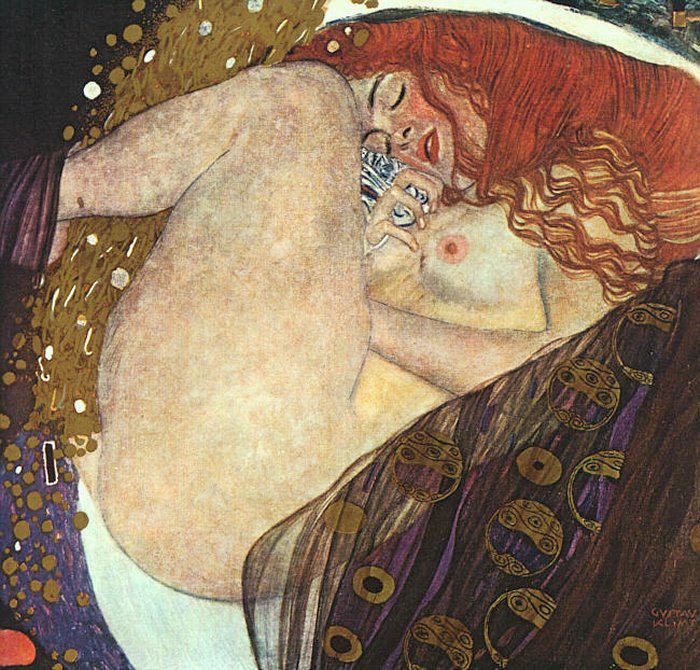
Klimt
The last two images show the next part of the story: after she gives birth to Zeus' son (Perseus), her father Acrisius discovers this and, still determined to avoid his fate, orders that Danaë and her child be sealed in a box and thrown into the sea. The first vase shows a carpenter using a drill while Danaë and her child wait, the other vase shows the pair now inside it, before being sealed and thrown into the sea.

Red Figure

Red Figure
The box with Danaë and little Perseus eventually came to shore on the island of Seriphos, where Perseus grew to manhood. The ruler of Seriphos, Polydectes, challenged Perseus to accomplish a near-impossible task: to retrieve the head of Medusa, one of the Gorgons, a group of monstrous females who have snakes instead of hair, and can turn someone to stone just by looking directly into their eyes.
The image below is a black-figure vase painting with Perseus preparing for his encounter by receiving equipment he will need from the Stygian Nymphs: one is giving him a pair of winged sandals, like the ones Hermes wears, which will give him the power of flight, the second one gives him the cap of darkness, an item on loan from Hades which makes the wearer invisible, the third gives him a sack in which to carry the severed head of Medusa. On the far left, behind Perseus, is Athena who acts as a sort of mentor to Perseus, a role she plays in regard to other notable heroes as well.

Black Figure
The next image is also from the Archaic period, a sculpted metope from a Greek temple at Selinus, which is on the island of Sicily. Here Perseus is in the act of beheading the monstrous Medusa (but careful not to look directly at her while doing it), while Athena again appears on the left. Medusa is seen holding a small horse. This is a reference to the birth of Pegasus, the flying horse, which emerged from her body after the head was cut off.

Selinus
The next image shows the Perseus metope in relation to two others on either side, separated by the triglyphs.

Three Metopes
Next is another red-figure vase painting with Perseus (seen on the far left in this view) being pursued by the other Gorgons, with the decapitated body of Medusa and Athena visible on the far right.

Red Figure
The last image here is the same scene in a black-figure vase painting, again with Athena, holding her skirt very daintily as she runs after Perseus.

Black Figure
Benvenuto Cellini (1500-1571) is one Renaissance artist for whom there is abundant information regarding his life and times, for he authored his autobiography, a vivid, colorful account in which he describes the creation of his famous bronze sculpture of Perseus in 1554.

Cellini
It was commissioned by Cosimo de Medici, the duke of Florence, to be displayed in the Loggia del Lanzi ("Swordsman's plaza") outside the Palazzo Vecchio in Florence. Another artist nearly persuaded the duke that Cellini's plan for casting it would not succeed, and even if it did, it would not be a great work. But Cellini convinced the duke to allow him to proceed, and worked intensely on the casting, using a method not employed since ancient times.

Detail
Cellini had great difficulties while he worked on it, literally making himself feverish. Fighting his ailment, he struggled to add some pewter to the bronze, and collapsed into bed, convinced he was dying. But he revived, and afterward removed the mold and found that it had cast perfectly. The day it was unveiled to the public, the duke listened in to hear what was being said, and learned that the citizens were trying to outdo one another with their highest praise for the work.

Left
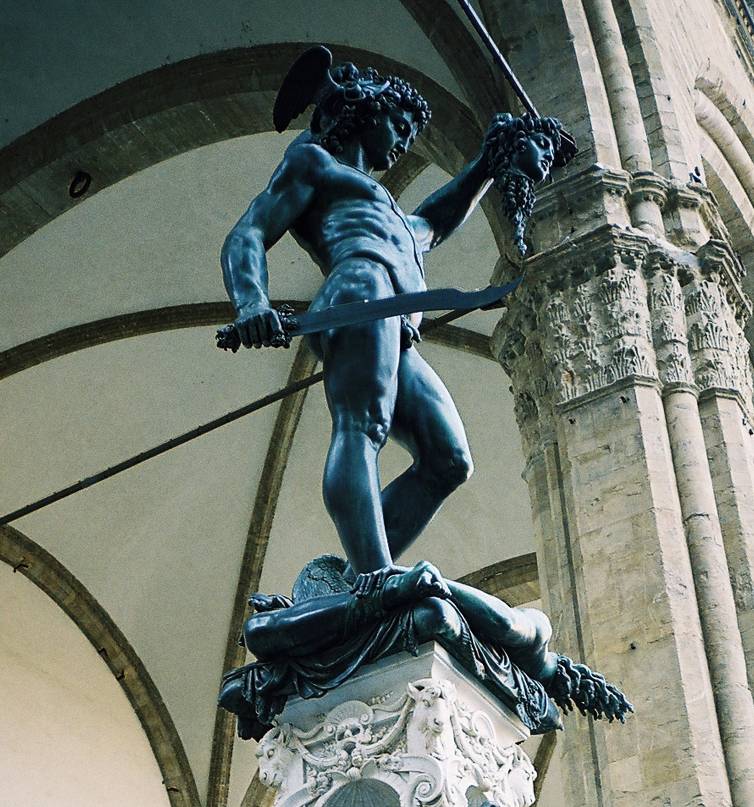
Right 1
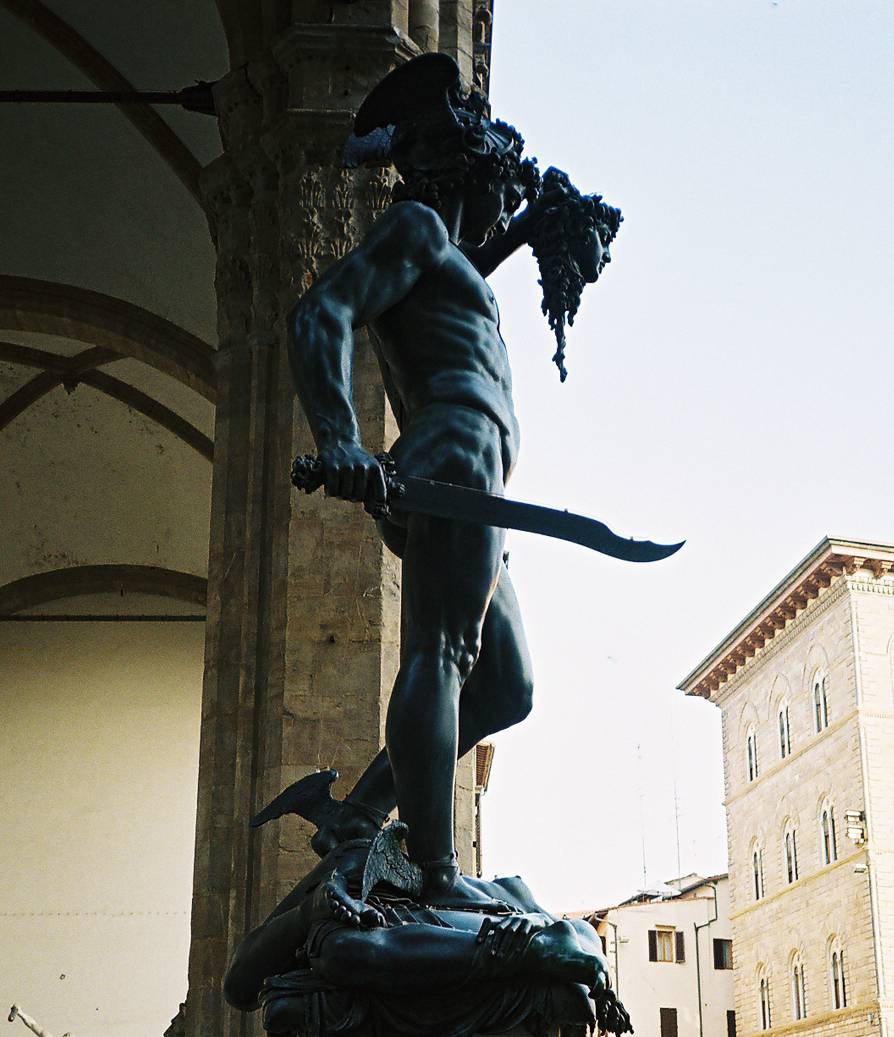
Right 2
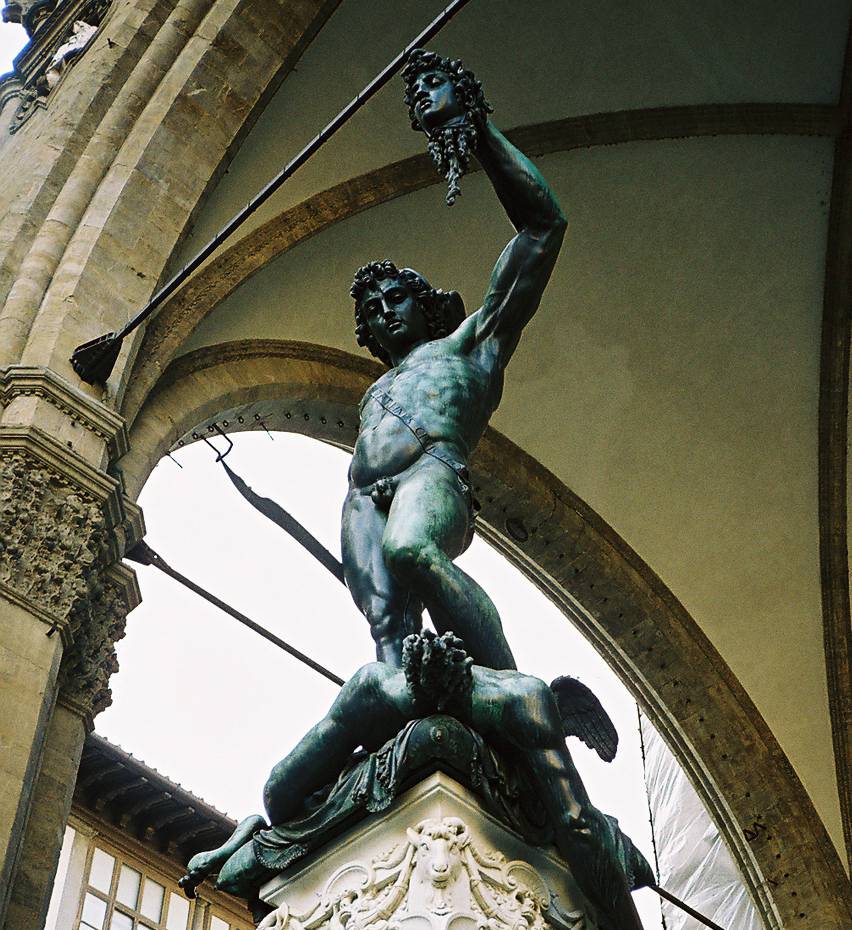
Below
This image shows a detail of two of the four gods (Zeus and Athena) included on each side of the base.
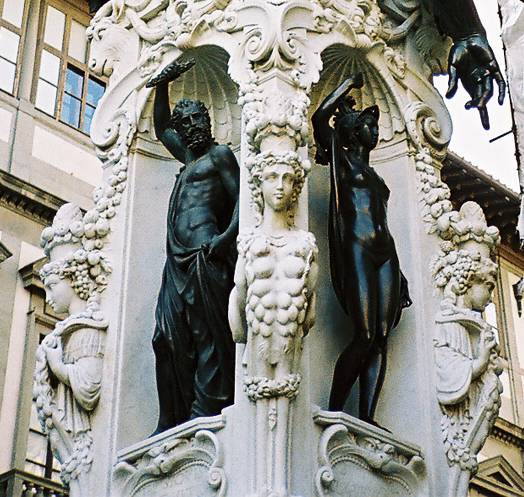
Pedestal
The last is a painting of the Perseus by night by John Singer Sargent, late 1800s.
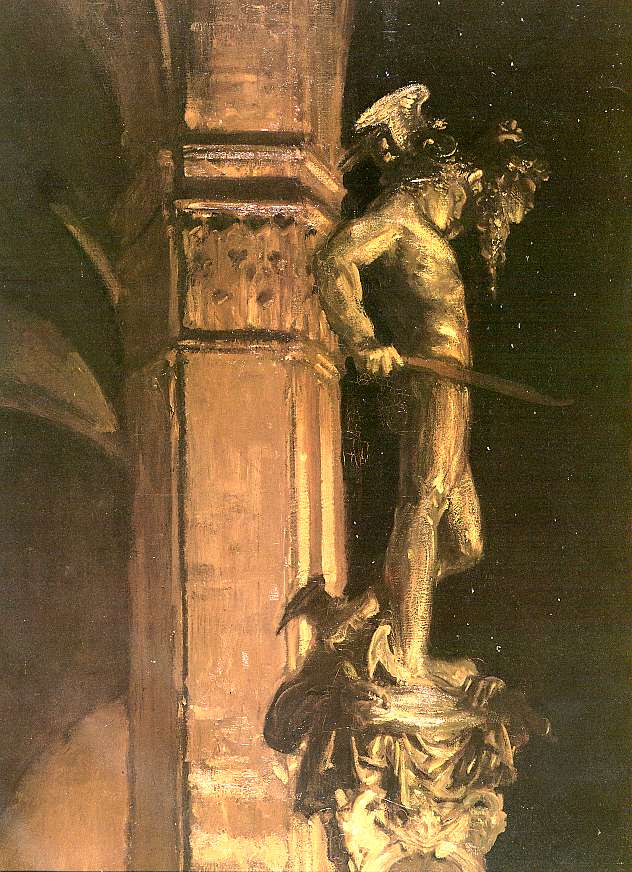
Sargent
One of the dozens of panels in the Farnese gallery by Carracci shows the scene of Medusa being beheaded. In this scene, Athena takes a more active role than usual by holding Perseus' shield so that he can see the reflection and avoid being turned to stone.

Carracci
Antonio Canova (1757-1822), one of the major artists of the Neoclassical period, made this version of Perseus about 1800.
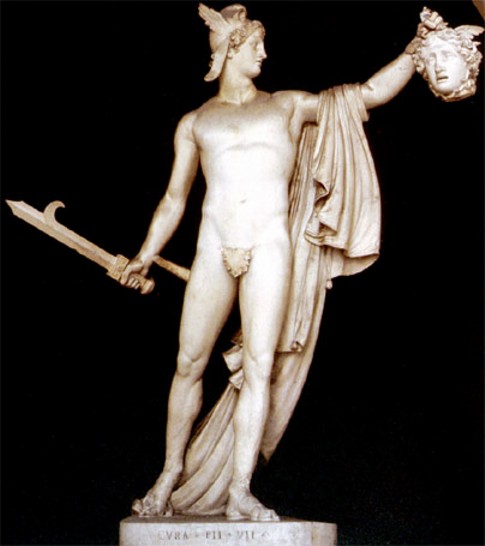
Canova
Another mural from the Boston Museum by Sargent shows Perseus riding the horse Pegasus, not technically accurate but a dynamic visual image.
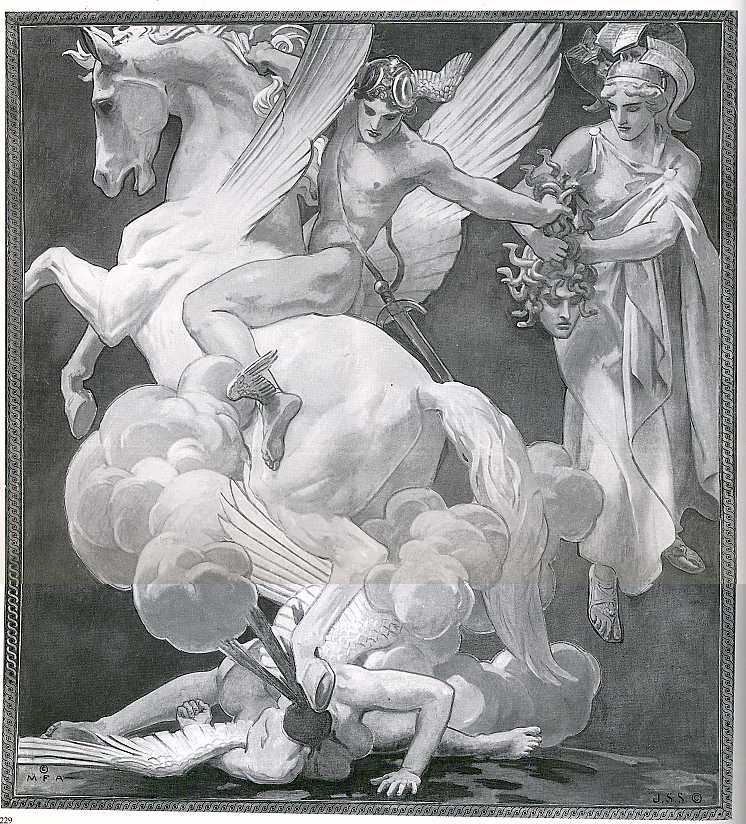
Sargent
The last three show just the head of Medusa, an image intended for shock value. First, the painting by Rubens, then a version by Caravaggio, and lastly a sculpture believed to be by Bernini, but which may have been done by one of his followers.

Rubens

Caravaggio
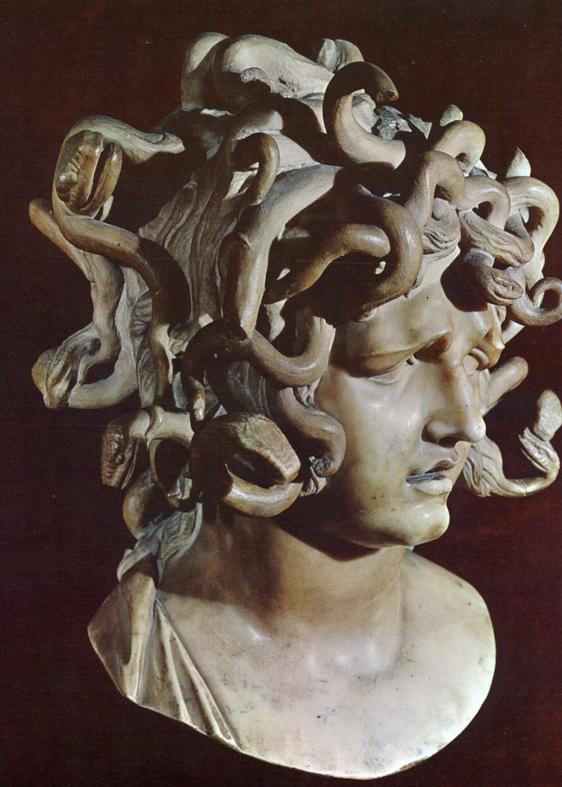
Bernini
The beheading of Medusa was not the only great adventure of Perseus, for as he was returning home (flying with his winged sandals), he spotted an unusual sight: a beautiful naked girl was chained to a rock at the seashore. Upon inquiring about this, he learns that she is the princess Andromeda, daughter of Cepheus and Cassiopoia, who is being sacrificed to a sea-monster as punishment for her mother's foolish bragging that she and her daughter were more beautiful than the Nereids, goddesses of the sea.
Perseus offered to rescue the girl, if he can then marry her, an offer agreed to by her father Cepheus. The image below is a >wall painting from Pompeii with Andromeda chained to the rock, while Perseus can be seen on the right shaking hands with Cepheus (but Perseus is also visible on the left, arriving on the scene, a sort of 'double-exposure' effect to convey a sense of action).

Pompeii 1
The second wall painting shows the happy ending with Perseus liberating Andromeda, with the head of Medusa hanging at his side.

Pompeii 2
The next image is Pierre-Étienne Monnot's sculpture of Andromeda and the monster, done about 1700.

Monnot
Frederick Leighton (1830-1896) painted this dramatic version of Andromeda chained to the rock.

Perseus and Andromeda - Leighton (c. 1891)
The sculpture by Cellini described above has this bronze relief attached to the pedestal, depicting this part of Perseus' story.
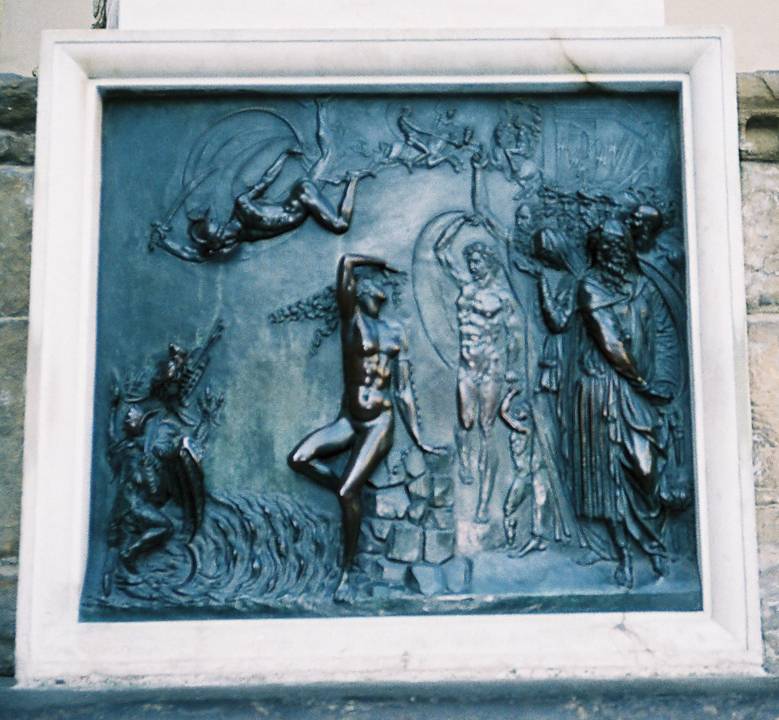
Cellini
One of the most prominent artists of the Pre-Raphaelite school, Edward Burne-Jones (1833-1898) studied under the painter Dante Rossetti (1828-1882), one the founders of the movement. Pre-Raphaelite was a trend of art heavily drawing upon myth, fantasy and symbolism. Burne-Jones was obviously strongly attracted to the Perseus story, for here are a total of seven different paintings, in various stages of completion, done between 1875-1888.
Perseus and the Graiae, a group of three females who had information he needed to find Medusa. They refused to help, but Perseus snatched away the one eye and one tooth that the three had to share, and then they were forced to give him assistance.
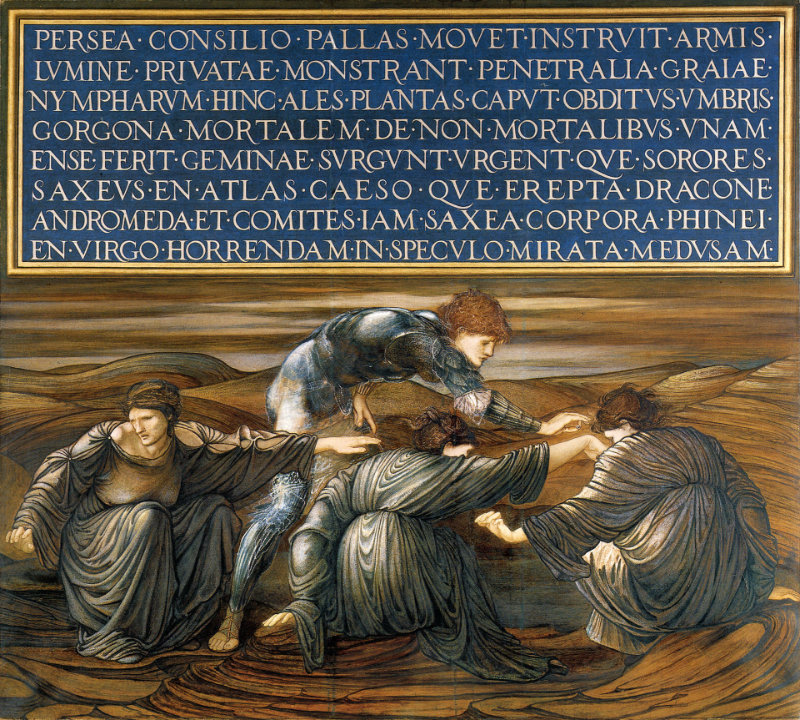
Perseus and the Graiae
Perseus and the Stygian nymphs, giving him the winged sandals, the cap, and the sack.
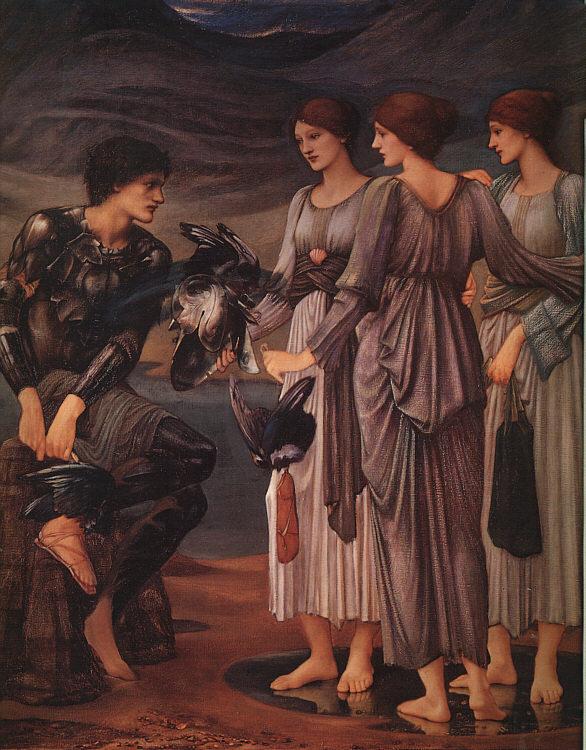
Perseus and the Sea Nymphs
The birth of Pegasus from the body of Medusa.
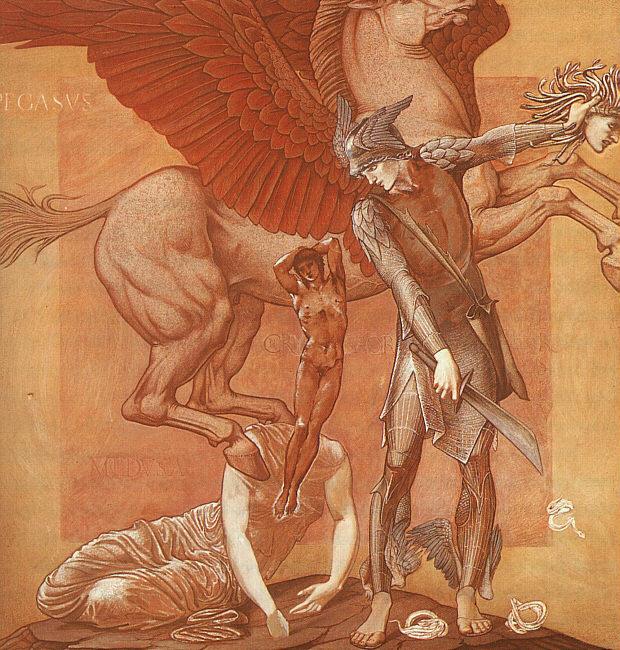
The Birth of Pegasus and Chrysaor
The swarming of the other Gorgons and the escape of Perseus.
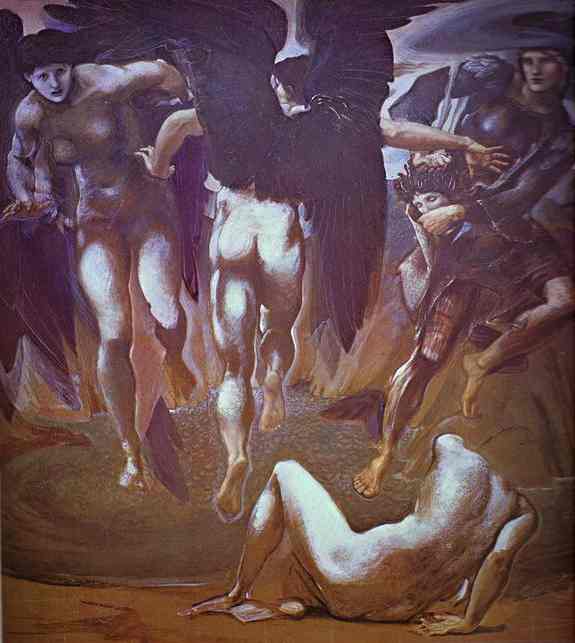
The Death of Medusa
His encounter with Andromeda.

The Rock of Doom
Perseus slaying the creature.
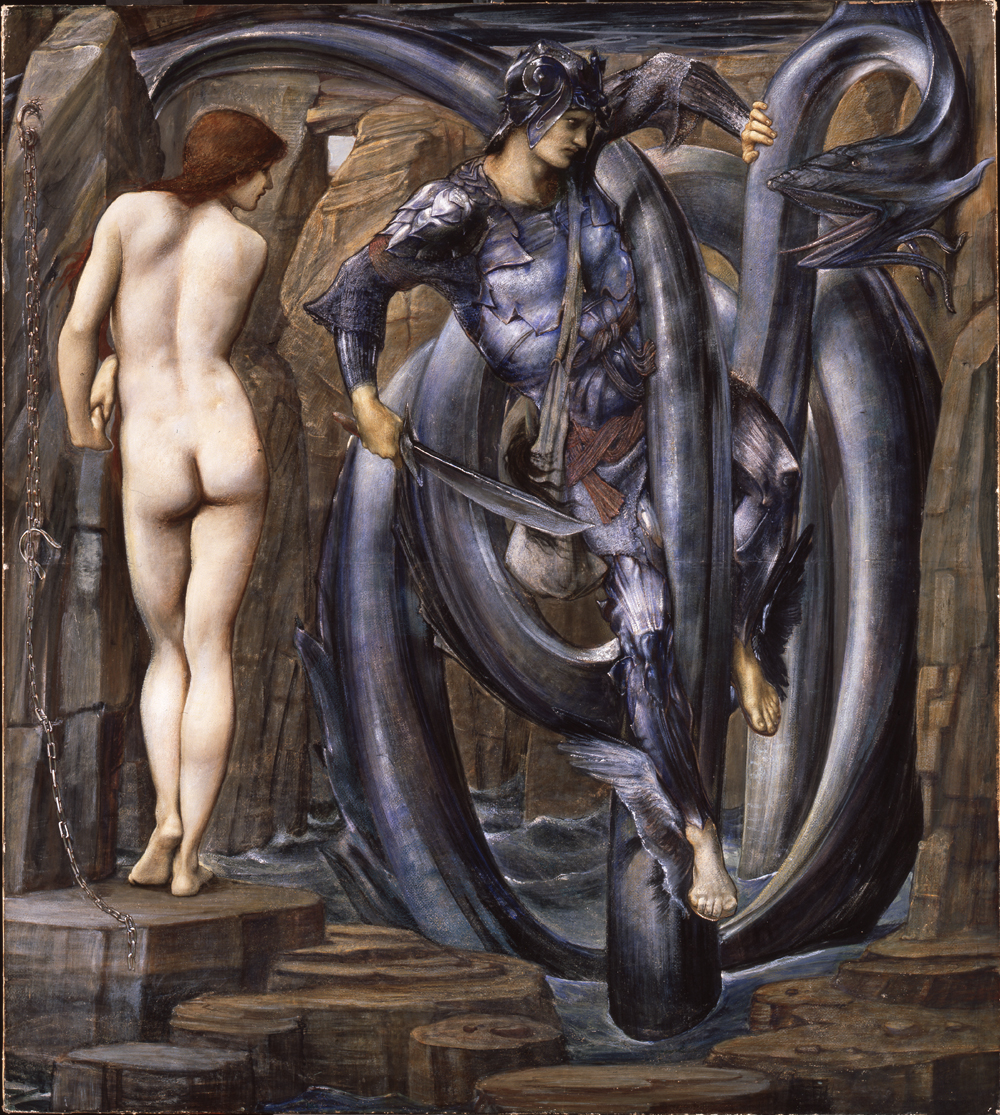
The Doom Fulfilled
Perseus and Andromeda gaze upon Medusa's head reflected in a water basin.

The Baleful Head